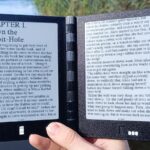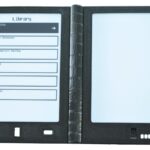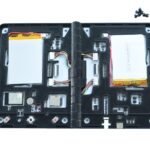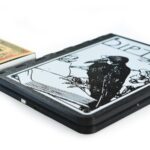Here is an e-reader device that appeared on Reddit and breaks all norms with its dual-screen display layout. The Diptyx DIY e-reader project was started by Reddit user “spacerower” and has reached the pre-launch stage on Crowdsupply. We first came to know of the device last month, and what is good to see is that the same is still being pursued.
The said e-reader comes with a pair of 5.83-inch E Ink displays that open and close like a real book. The monochrome displays have a 648 × 480 resolution each. An ESP32‑S3-N16R8 processor makes up the core of the device and is coupled with 16 MB flash, along with 8 MB RAM. Storage available amounts to 2 GB via SD cards. Power comes from a pair of 1,500 mAh Li-Po batteries along with tps6284 buck converter. This ensures a few weeks of normal usage and several months of standby time.
The Diptyx DIY e-reader runs an open-source firmware with no DRM requirement. What that means is you can read normal, unencrypted EPUB files that you download or create yourself. You won’t be required to sign in to any cloud account or store and will be able to keep your books forever, even if a store or platform shuts down. In short, you own both the hardware and the software, which is unlike many commercially available e-reader devices, such as the Kindle. A salient feature of the Diptyx DIY e-reader is the presence of 3 3-way buttons + 2 buttons for page turning and navigating the menu options.
Coming to dimensions, the Diptyx DIY e-reader, as CrowdSupply mentioned, measures 120 × 150 × 14 mm in its closed state. When opened, it measures 226 × 150 × 14 mm and weighs 300 grams. It features a USB Type-C port for charging the batteries as well as for data transfer. The source also mentions the e-reader does not have Wi-Fi or Bluetooth features enabled as yet, even though the chip supports it.
It being a dual-screen design with a hinge at the middle, the two individual screens fold at the middle to mimic a real book. The advantage here is its similarity with a paperback, as you have two pages visible at the same time. Also, the two displays remain unexposed when closed and are hence protected from accidental scratches and dents. The e-reader also enters a deep-sleep state when closed, thereby saving battery power.
On the flip side, a dual-screen design is always thicker compared to its single-screen counterpart. This makes them less portable and cannot easily be operated with a single hand, as is often the case with traditional e-readers like Kindle that have a thin and light build. You will have to deal with it in the same manner as you would a normal paperback.
Further, since it is a DIY/open-hardware project and not a mass-market commercial product, there might be issues related to build quality and support. The creator, though, has stated the emphasis is on designing an e-reader that offers a complete ownership experience – be it hardware or software – while being easy to repair as well.
The creator has hinted at a forthcoming crowdfunding campaign via Crowd Supply, though no specific launch schedule has been revealed as yet. Subscribe to the CrowdSupply page for regular updates on this. The design files, which include the schematics, PCB, and case, are promised to be made open-source once the final design and spec sheet are fixed.
In the end, the Diptyx DIY e-reader is an exciting project where the focus is less on providing users with a vendor-managed ecosystem. Rather, the emphasis is more on letting users have an undiluted device ownership experience. What remains to be seen is how soon we will be able to have the final thing in our hands. Stay tuned.







